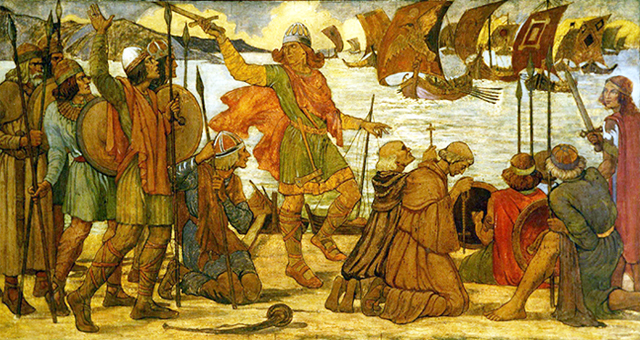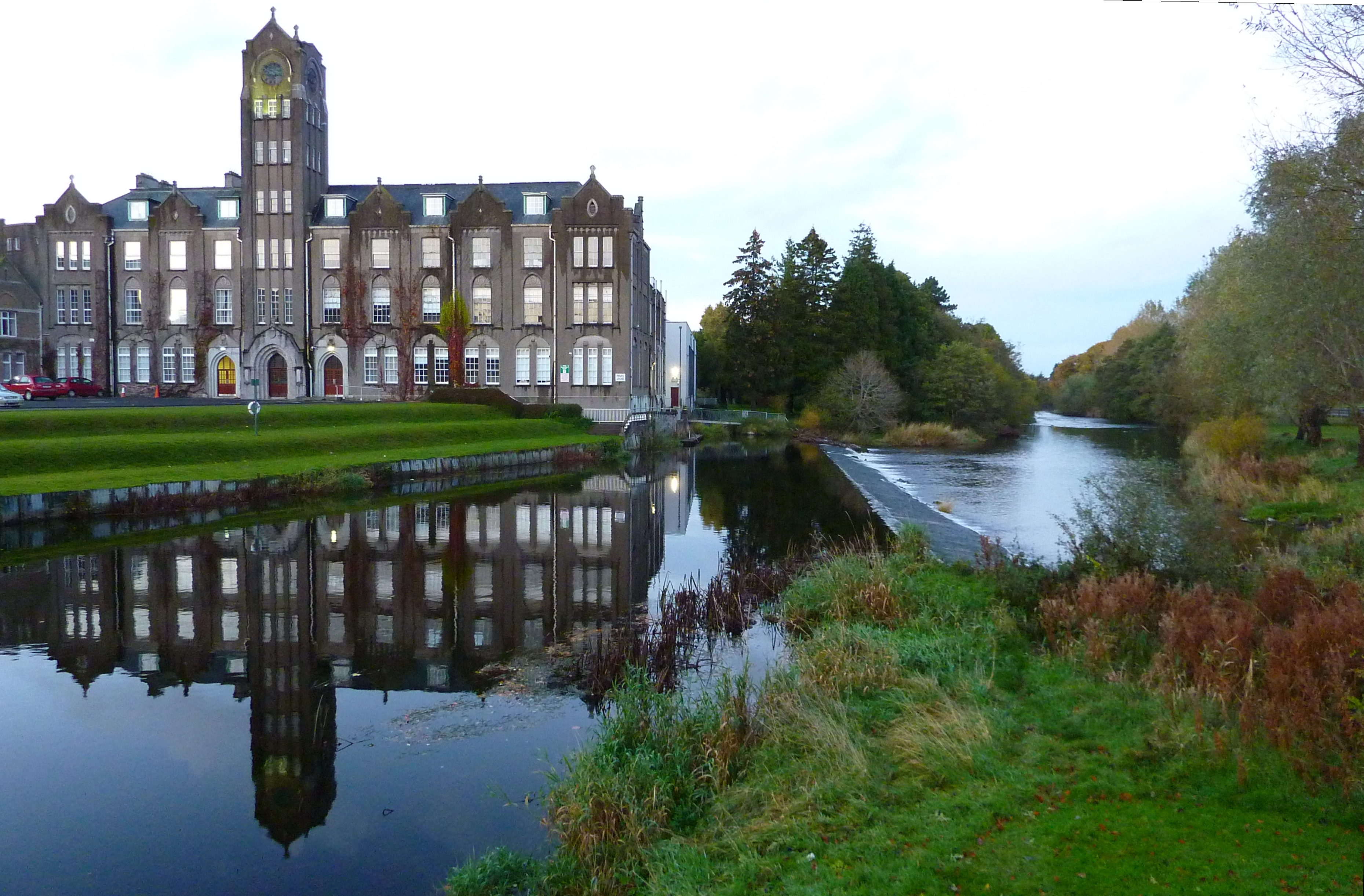|
Eblani
The Eblani ( แผฮฒฮปฮฌฮฝฮฟฮน) or Eblanii ( แผฮฒฮปฮฌฮฝฮนฮฟฮน) (manuscript variants: Ebdani แผฮฒฮดฮฑฮฝฮฟฮฏ Blani ๏ฟฝฮปฮฌฮฝฮฟฮน Blanii ๏ฟฝฮปฮฌฮฝฮนฮฟฮน were a people of ancient Ireland uniquely recorded in Ptolemy's 2nd-century ''Geography'', in which they inhabit a region on the east coast, roughly north of County Dublin. Ptolemy also lists a "city" called Eblana ( แผฮฒฮปฮฑฮฝฮฑ), which he locates between the estuaries of the rivers Buvinda (ฮฮฟฯ ฮฟฯ ฮฏฮฝฮดฮฑ) and Oboca (แพฟฮฮฒฯฮบฮฑ), implying a coastal site between the Boyne and probably the Liffey respectively. O'Rahilly tentatively suggested that the tribal name, which he speculatively reconstructed as ''*Ebodanฤซ'', may have survived in the toponym Edmann, a region on the east coast, probably in County Louth, occasionally mentioned in early texts. O'Rahilly's line of reasoning was inspired by the form ''Ebdanoi'' แผฮฒฮดฮฑฮฝฮฟฮฏfound in one manuscript family of Ptolemy's work, but this variant is demonstrably the result of ... [...More Info...] [...Related Items...] OR: [Wikipedia] [Google] [Baidu] |
Ireland
Ireland (, ; ; Ulster Scots dialect, Ulster-Scots: ) is an island in the North Atlantic Ocean, in Northwestern Europe. Geopolitically, the island is divided between the Republic of Ireland (officially Names of the Irish state, named Irelanda sovereign state covering five-sixths of the island) and Northern Ireland (part of the United Kingdomcovering the remaining sixth). It is separated from Great Britain to its east by the North Channel (Great Britain and Ireland), North Channel, the Irish Sea, and St George's Channel. Ireland is the List of islands of the British Isles, second-largest island of the British Isles, the List of European islands by area, third-largest in Europe, and the List of islands by area, twentieth-largest in the world. As of 2022, the Irish population analysis, population of the entire island is just over 7 million, with 5.1 million in the Republic of Ireland and 1.9 million in Northern Ireland, ranking it the List of European islands by population, ... [...More Info...] [...Related Items...] OR: [Wikipedia] [Google] [Baidu] |
Ptolemy
Claudius Ptolemy (; , ; ; โ 160s/170s AD) was a Greco-Roman mathematician, astronomer, astrologer, geographer, and music theorist who wrote about a dozen scientific treatises, three of which were important to later Byzantine science, Byzantine, Islamic science, Islamic, and Science in the Renaissance, Western European science. The first was his astronomical treatise now known as the ''Almagest'', originally entitled ' (, ', ). The second is the ''Geography (Ptolemy), Geography'', which is a thorough discussion on maps and the geographic knowledge of the Greco-Roman world. The third is the astrological treatise in which he attempted to adapt horoscopic astrology to the Aristotelian physics, Aristotelian natural philosophy of his day. This is sometimes known as the ' (, 'On the Effects') but more commonly known as the ' (from the Koine Greek meaning 'four books'; ). The Catholic Church promoted his work, which included the only mathematically sound geocentric model of the Sola ... [...More Info...] [...Related Items...] OR: [Wikipedia] [Google] [Baidu] |
Geography (Ptolemy)
The ''Geography'' (, , "Geographical Guidance"), also known by its Latin names as the ' and the ', is a gazetteer, an atlas (book), atlas, and a treatise on cartography, compiling the geographical knowledge of the 2nd-century Roman Empire. Originally written by Claudius Ptolemy in Ancient Greek, Greek at Alexandria around 150 AD, the work was a revision of a now-lost atlas by Marinus of Tyre using additional Roman and Parthian Empire, Persian gazetteers and new principles. Its translation โ Al-Khwarizmi#Geography, Kitab Surat al-Ard โ into Classical Arabic, Arabic by Al-Khwarizmi, Al-Khwarismi in the 9th century was highly influential on the geographical knowledge and cartographic traditions of the Geography and cartography in medieval Islam, Islamic world. Alongside the works of Islamic scholars โ and the commentary containing revised and more accurate data by Alfraganus โ Ptolemy's work was subsequently highly influential on Middle Ages, Medieval and Renaissanc ... [...More Info...] [...Related Items...] OR: [Wikipedia] [Google] [Baidu] |
County Dublin
County Dublin ( or ) is a Counties of Ireland, county in Republic of Ireland, Ireland, and holds its capital city, Dublin. It is located on the island's east coast, within the Provinces of Ireland, province of Leinster. Until 1994, County Dublin (excluding the city) was a single Local government in the Republic of Ireland, local government area; in that year, the county council was divided into three new administrative counties: Dรบn LaoghaireโRathdown, Fingal and South Dublin. The three administrative counties together with Dublin City proper form a NUTS III NUTS statistical regions of Ireland, statistical region of Ireland (coded IE061). County Dublin remains a single administrative unit for the purposes of the courts (including the Dublin County Sheriff, but excluding the bailiwick of the Dublin City Sheriff) and Dublin County combined with Dublin City forms the Judicial County of Dublin, including Dublin Circuit Court, the Dublin County Registrar and the Dublin Metropolitan ... [...More Info...] [...Related Items...] OR: [Wikipedia] [Google] [Baidu] |
Eblana
Eblana () is an ancient Irish settlement that appears in the '' Geographia'' of Claudius Ptolemaeus (Ptolemy), the Greek astronomer and cartographer, around the year 140 AD. It was traditionally believed by scholars to refer to the same site as the modern city of Dublin. The 19th-century writer Louis Agassiz used ''Eblana'' as a Latin equivalent for Dublin. However, more recent scholarship favours the north County Dublin seaside village of Loughshinny due to its proximity to Drumanagh, an important trading site with links to Roman Britain; it has even been described as a bridgehead of a possible Roman invasion. However, there is no definitive proof to tie Eblana to any location, so its exact identity remains a matter of speculation. Eblana as Dublin If the reference to a settlement in Ireland called ''Eblana'' is in fact the earliest reference to Dublin, this would seem to give Dublin a just claim to nearly two thousand years of antiquity, as the settlement must have existed ... [...More Info...] [...Related Items...] OR: [Wikipedia] [Google] [Baidu] |
River Boyne
The River Boyne ( or ''Abhainn na Bรณinne'') is a river in Leinster, Ireland, the course of which is about long. It rises at Trinity Well, Newberry Hall, near Carbury, County Kildare, and flows north-east through County Meath to reach the Irish Sea between Mornington, County Meath, and Baltray, County Louth. Names and etymology This river has been known since ancient times. The Greek geographer Ptolemy drew a map of Ireland in the 2nd century that included the Boyne, which he called (''Bouwinda'') or (''Boubinda''), which in Celtic means "white cow" (). During the High Middle Ages, Giraldus Cambrensis called it the ''Boandus''. In Irish mythology it is said that the river was created by the goddess Boann and Boyne is an anglicised form of the name. In other legends, it was in this river where Fionn mac Cumhail captured Fiontรกn, the Salmon of Knowledge. The Meath section of the Boyne was also known as ''Smior Fionn Feidhlimthe'' (the 'marrow of Fionn Feilim'). T ... [...More Info...] [...Related Items...] OR: [Wikipedia] [Google] [Baidu] |
River Liffey
The River Liffey (Irish language, Irish: ''An Life'', historically ''An Ruirthe(a)ch'') is a river in eastern Ireland that ultimately flows through the centre of Dublin to its mouth within Dublin Bay. Its major Tributary, tributaries include the River Dodder, the River Poddle and the River Camac. The river supplies much of Dublin's water and supports a range of recreational activities. Name While Ptolemy's ''Geography (Ptolemy), Geography'' (2nd century AD) describes a river which he labels ฮฮฒฮฟฮบฮฑ (''Oboka''), this is not the Liffey: ultimately it leads to the name of the River Avoca in County Wicklow. According to "Place Names from our Older Literature - IV." by Boswell, C. S. (1904ย Connradh na Gaedhilge) the river takes its name from Magh Life, i.e. the plain of Kildare through which the Life flows. This in turn takes its name from Life, daughter of Canann Curthach, who eloped with and married Deltbanna mac Druchta, cup-bearer to Conaire Mรณr High King of Ireland. Life ... [...More Info...] [...Related Items...] OR: [Wikipedia] [Google] [Baidu] |
County Louth
County Louth ( ; ) is a coastal Counties of Ireland, county in the Eastern and Midland Region of Republic of Ireland, Ireland, within the Provinces of Ireland, province of Leinster. Louth is bordered by the counties of County Meath, Meath to the south, County Monaghan, Monaghan to the west, County Armagh, Armagh to the north and County Down, Down to the north-east, across Carlingford Lough. It is the List of Irish counties by area, smallest county in Ireland by land area and the List of Irish counties by population, 17th most populous, with just over 139,100 residents 2022 census of Ireland, as of 2022. The county is named after the village of Louth, County Louth, Louth. Louth County Council is the Local government in the Republic of Ireland, local authority for the county. History County Louth is named after the Louth, County Louth, village of Louth, which in turn is named after Lugh, a god of the ancient Irish. Historically, the placename has had various spellings; , , and ( ... [...More Info...] [...Related Items...] OR: [Wikipedia] [Google] [Baidu] |
Uncial Script
Uncial is a majuscule script (written entirely in capital letters) commonly used from the 4th to 8th centuries AD by Latin and Greek scribes. Uncial letters were used to write Greek and Latin, as well as Gothic, and are the current style for Coptic and Nobiin. Development Early uncial script most likely developed from late rustic capitals. Early forms are characterized by broad single-stroke letters using simple round forms taking advantage of the new parchment and vellum surfaces, as opposed to the angular, multiple-stroke letters, which are more suited for rougher surfaces, such as papyrus. In the oldest examples of uncial, such as the fragment of '' De bellis macedonicis'' in the British Library, of the late 1stโearly 2nd centuries, all of the letters are disconnected from one another, and word separation is typically not used. Word separation, however, is characteristic of later uncial usage. As the script evolved over the centuries, the characters became more com ... [...More Info...] [...Related Items...] OR: [Wikipedia] [Google] [Baidu] |







